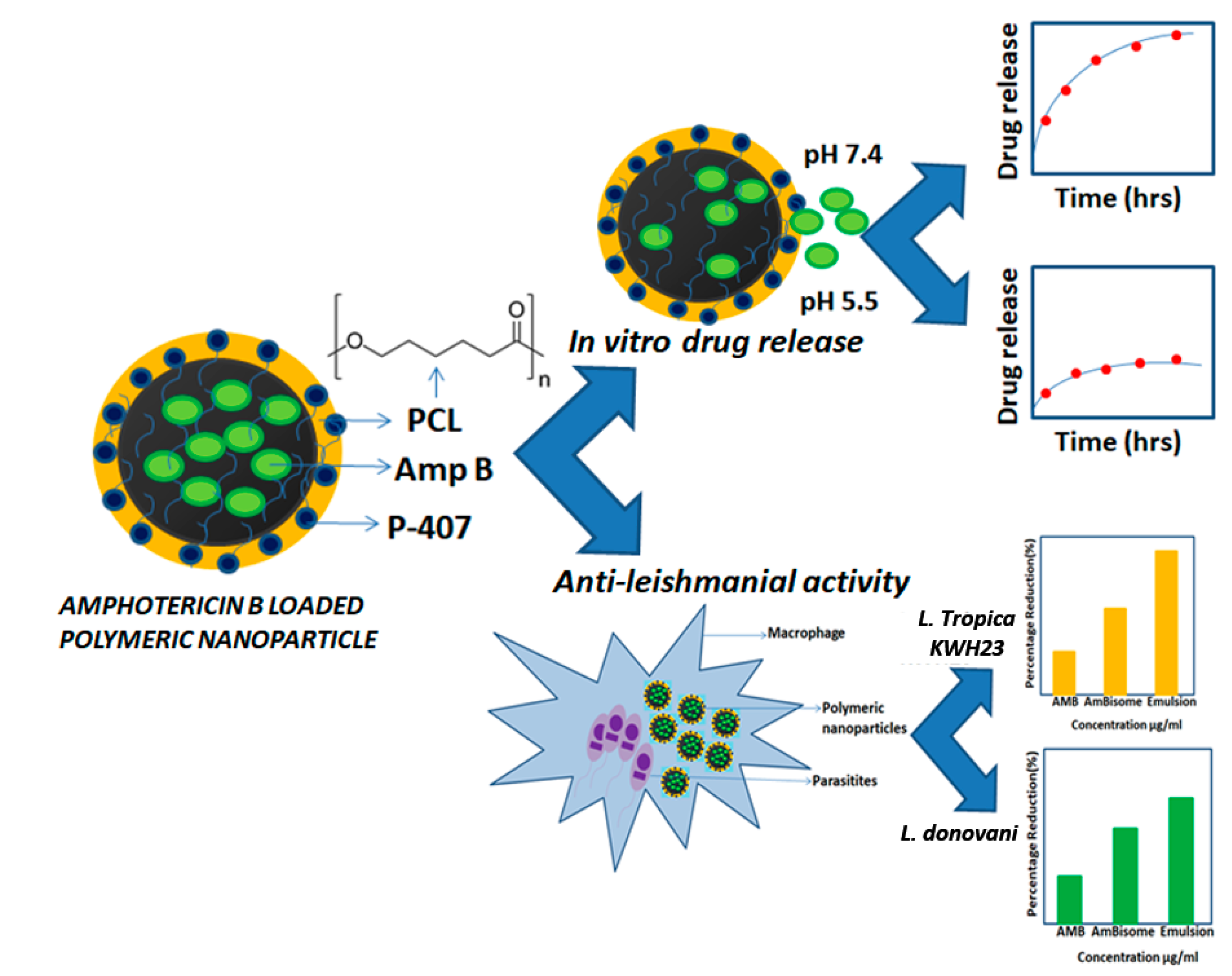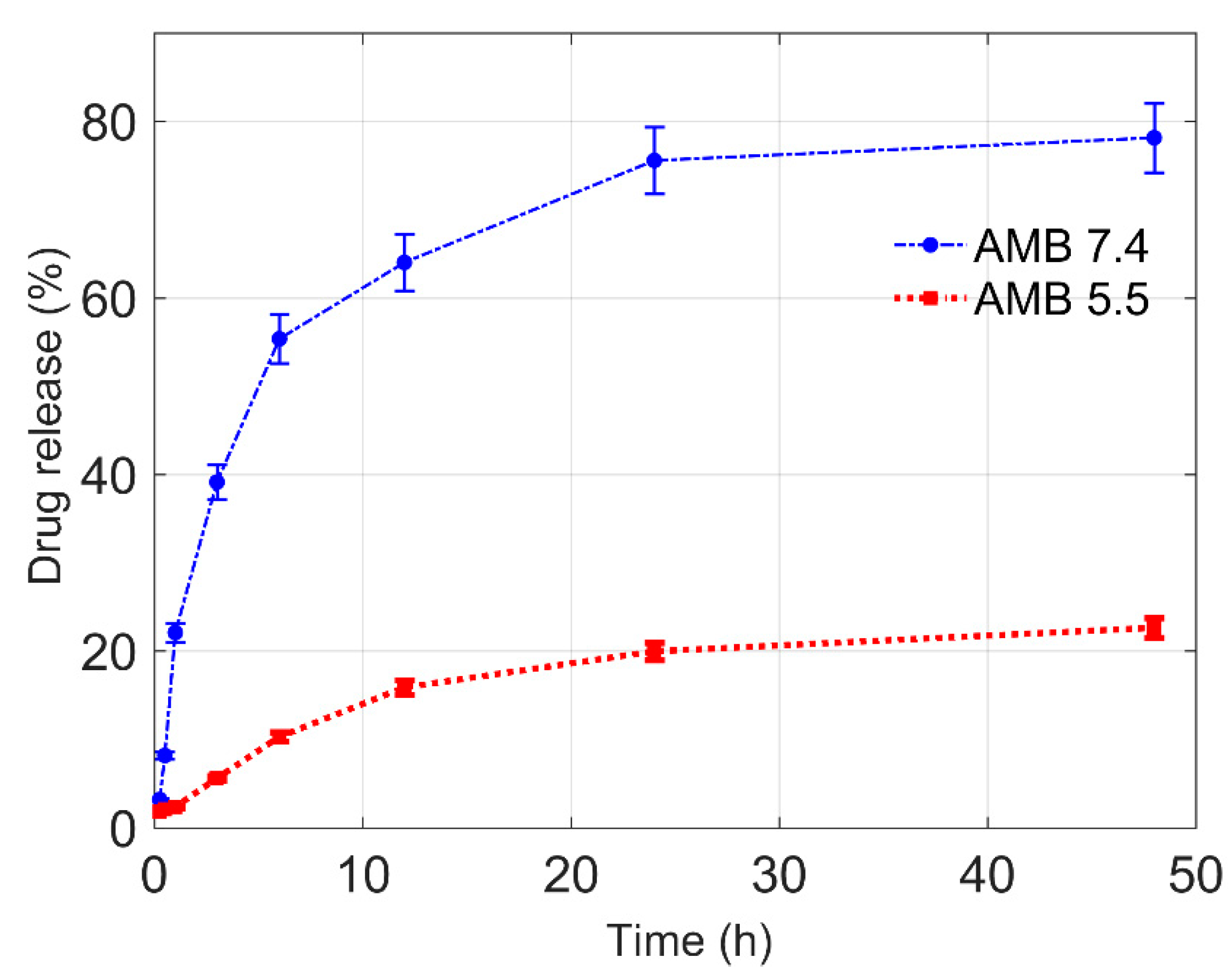Amphotericin B Loaded Polymeric Nanoparticles for Treatment of Leishmania Infections
Abstract
1. Introduction
2. Materials and Methods
2.1. Materials
2.2. Methods
2.2.1. Preparation of Solutions
2.2.2. Formulation of Drug-Loaded Emulsion
2.3. Characterization Techniques
2.4. In Vitro Drug Release Studies and Release Kinetics
2.5. In Vitro Anti-Leishmanial Activities
3. Results and Discussion
3.1. Optimization and Stability of the Formulations
3.2. Size and Morphology of Prepared Polymeric Nanoparticles
3.3. Surface Charge and Particle Size Distribution
3.4. In Vitro Drug Release Study
3.5. Encapsulation Efficiency
3.6. Pharmacological Evaluation of Anti-Leishmanial Activities
4. Conclusions
Author Contributions
Funding
Conflicts of Interest
References
- Steinbach, W.J.; Stevens, D.A. Review of Newer Antifungal and Immunomodulatory Strategies for Invasive Aspergillosis. Clin. Infect. Dis. 2003, 37, S157–S187. [Google Scholar] [CrossRef]
- Mohamed-Ahmed, A.H.A.; Brocchini, S.; Croft, S.L. Recent advances in development of amphotericin B formulations for the treatment of visceral leishmaniasis. Curr. Opin. Infect. Dis. 2012, 25, 695–702. [Google Scholar] [CrossRef]
- Vitorino, C.; Almeida, A.; Sousa, J.; Lamarche, I.; Gobin, P.; Marchand, S.; Couet, W.; Olivier, J.-C.; Pais, A. Passive and active strategies for transdermal delivery using co-encapsulating nanostructured lipid carriers: In vitro vs. in vivo studies. Eur. J. Pharm. Biopharm. 2014, 86, 133–144. [Google Scholar] [CrossRef]
- Vardy, D.; Barenholz, Y.; Naftoliev, N.; Klaus, S.; Gilead, L.; Frankenburg, S. Efficacious topical treatment for human cutaneous leishmaniasis with ethanolic lipid amphotericin B. Trans. R. Soc. Trop. Med. Hyg. 2001, 95, 184–186. [Google Scholar] [CrossRef]
- Reis, C.P.; Neufeld, R.J.; Ribeiro, A.J.; Veiga, F.; Nanoencapsulation, I. Methods for preparation of drug-loaded polymeric nanoparticles. Nanomed. Nanotechnol. Biol. Med. 2006, 2, 8–21. [Google Scholar] [CrossRef]
- Amoabediny, G.; Haghiralsadat, F.; Naderinezhad, S.; Helder, M.N.; Kharanaghi, E.A.; Arough, J.M.; Zandieh-Doulabi, B. Overview of preparation methods of polymeric and lipid-based (niosome, solid lipid, liposome) nanoparticles: A comprehensive review. Int. J. Polym. Mater. Polym. Biomater. 2018, 67, 383–400. [Google Scholar] [CrossRef]
- Nahar, M.; Mishra, D.; Dubey, V.; Jain, N.K. Development, characterization, and toxicity evaluation of amphotericin B–loaded gelatin nanoparticles. Nanomed. Nanotechnol. Biol. Med. 2008, 4, 252–261. [Google Scholar] [CrossRef] [PubMed]
- Ayoub, M.; Ahmed, N.; Kalaji, N.; Charcosset, C.; Magdy, A.; Fessi, H.; Elaissari, A. Study of the Effect of Formulation Parameters/Variables to Control the Nanoencapsulation of Hydrophilic Drug via Double Emulsion Technique. J. Biomed. Nanotechnol. 2011, 7, 255–262. [Google Scholar] [CrossRef] [PubMed]
- TiyaboonchaiI, W.; Limpeanchob, N. Formulation and characterization of amphotericin B–chitosan–dextran sulfate nanoparticles. Int. J. Pharm. 2007, 329, 142–149. [Google Scholar] [CrossRef] [PubMed]
- Harisa, G.I.; Alomrani, A.H.; Badran, M.M. Simvastatin-loaded nanostructured lipid carriers attenuate the atherogenic risk of erythrocytes in hyperlipidemic rats. Eur. J. Pharm. Sci. 2017, 96, 62–71. [Google Scholar] [CrossRef]
- Chen, Y.; Quan, P.; Liu, X.; Wang, M.; Fang, L. Novel chemical permeation enhancers for transdermal drug delivery. Asian J. Pharm. Sci. 2014, 9, 51–64. [Google Scholar] [CrossRef]
- Notman, R.; den Otter, W.K.; Noro, M.G.; Briels, W.J.; Anwar, J. The Permeability Enhancing Mechanism of DMSO in Ceramide Bilayers Simulated by Molecular Dynamics. Biophys. J. 2007, 93, 2056–2068. [Google Scholar] [CrossRef]
- Amanujamv, R.; Sundaram, B.; Janarthanan, G.; Devendran, E.; Venkadasalam, M.; Milton, M.C.J. Biodegradable Polycaprolactone Nanoparticles Based Drug Delivery Systems: A Short Review. Biosci. Biotech. Res. Asia 2018, 15, 679–685. [Google Scholar]
- Rai, A.; Senapati, S.; Saraf, S.K.; Maiti, P. Biodegradable poly(ε-caprolactone) as a controlled drug delivery vehicle of vancomycin for the treatment of MRSA infection. J. Mater. Chem. B 2016, 4, 5151–5160. [Google Scholar] [CrossRef] [PubMed]
- Nasr, F.H.; Khoee, S.; Dehghan, M.M.; Chaleshtori, S.S.; Shafiee, A. Preparation and Evaluation of Contact Lenses Embedded with Polycaprolactone-Based Nanoparticles for Ocular Drug Delivery. Biomacromolecules 2016, 17, 485–495. [Google Scholar] [CrossRef] [PubMed]
- Baishya, H. Application of Mathematical Models in Drug Release Kinetics of Carbidopa and Levodopa ER Tablets. J. Dev. Drugs 2017, 6, 1–8. [Google Scholar] [CrossRef]
- Chen, J.; Luo, Y.; Hong, L.; Ling, Y.; Pang, J.; Fang, Y.; Wei, K.; Gao, X. Synthesis, characterization and osteoconductivity properties of bone fillers based on alendronate-loaded poly(ε-caprolactone)/hydroxyapatite microspheres. J. Mater. Sci. Mater. Med. 2011, 22, 547–555. [Google Scholar] [CrossRef]
- Dumortier, G.; Grossiord, J.L.; Agnely, F.; Chaumeil, J.C. A Review of Poloxamer 407 Pharmaceutical and Pharmacological Characteristics. Pharm. Res. 2006, 23, 2709–2728. [Google Scholar] [CrossRef]
- Sharma, N.; Madan, P.; Lin, S. Effect of process and formulation variables on the preparation of parenteral paclitaxel-loaded biodegradable polymeric nanoparticles: A co-surfactant study. Asian J. Pharm. Sci. 2016, 11, 404–416. [Google Scholar] [CrossRef]
- Ajiboye, A.L.; Trivedi, V.; Mitchell, J.C. Preparation of polycaprolactone nanoparticles via supercritical carbon dioxide extraction of emulsions. Drug Deliv. Transl. Res. 2017, 8, 1790–1796. [Google Scholar] [CrossRef]
- Charoenchaitrakool, M.; Dehghani, F.; Foster, N.R.; Chan, H.K. Micronization by Rapid Expansion of Supercritical Solutions to Enhance the Dissolution Rates of Poorly Water-Soluble Pharmaceuticals. Ind. Eng. Chem. Res. 2000, 39, 4794–4802. [Google Scholar] [CrossRef]
- Fattahi, A.; Karimi-Sabet, J.; Keshavarz, A.; Golzary, A.; Rafiee-Tehrani, M.; Dorkoosh, F.A. Preparation and characterization of simvastatin nanoparticles using rapid expansion of supercritical solution (RESS) with trifluoromethane. J. Supercrit. Fluids 2016, 107, 469–478. [Google Scholar] [CrossRef]
- Blanco, E.; Shen, H.; Ferrari, M. Principles of nanoparticle design for overcoming biological barriers to drug delivery. Nat. Biotechnol. 2015, 33, 941–951. [Google Scholar] [CrossRef]
- Kim, C.-S.; Saylor, D.M.; McDermott, M.K.; Patwardhan, D.V.; Warren, J.A. Modeling solvent evaporation during the manufacture of controlled drug-release coatings and the impact on release kinetics. J. Biomed. Mater. Res. B Appl. Biomater. 2009, 90B, 688–699. [Google Scholar] [CrossRef]
- Balmayor, E.R.; Tuzlakoglu, K.; Azevedo, H.S.; Reis, R.L. Preparation and characterization of starch-poly-ε-caprolactone microparticles incorporating bioactive agents for drug delivery and tissue engineering applications. Acta Biomater. 2009, 5, 1035–1045. [Google Scholar] [CrossRef][Green Version]
- Mallikarjuna, B.; Rao, K.; Prasad, C.; Rao, K.; Subha, M.C.S. Development of triprolidine-hydrochloride-loaded ph-sensitive poly(acrylamide-co-acrylamidoglycolic acid) co-polymer microspheres: I In Vitro/I release studies. Des. Monomers Polym. 2011, 14, 445–459. [Google Scholar] [CrossRef]
- Ritger, P.L.; Peppas, N.A. A simple equation for description of solute release I. Fickian and non-fickian release from non-swellable devices in the form of slabs, spheres, cylinders or discs. J. Control. Release 1987, 5, 23–36. [Google Scholar] [CrossRef]
- Caccavo, D. An overview on the mathematical modeling of hydrogels’ behavior for drug delivery systems. Int. J. Pharm. 2019, 560, 175–190. [Google Scholar] [CrossRef]
- Higuchi, T. Rate of Release of Medicaments from Ointment Bases Containing Drugs in Suspension. J. Pharm. Sci. 1961, 50, 874–875. [Google Scholar] [CrossRef]
- Siepmann, J.; Peppas, N.A. Modeling of drug release from delivery systems based on hydroxypropyl methylcellulose (HPMC). Adv. Drug Deliv. Rev. 2012, 64, 163–174. [Google Scholar] [CrossRef]
- Khazaei, A.; Saednia, S.; Saien, J.; Kazem-Rostami, M.; Sadeghpour, M.; Borazjani, M.K.; Abbasi, F. Grafting Amino Drugs to Poly(styrene-alt-maleic Anhydride) as a Potential Method for Drug Release. J. Braz. Chem. Soc. 2013, 24, 1109–1115. [Google Scholar] [CrossRef]
- Ishaq, Z.-A.; Ahmed, N.; Anwar, M.N.; ul-Haq, I.; ur-Rehman, T.; Ahmad, N.M.; Elaissari, A. Development and in vitro evaluation of cost effective amphotericin B polymeric emulsion. J. Drug Deliv. Sci. Technol. 2018, 46, 66–73. [Google Scholar] [CrossRef]
- Palma, E.; Pasqua, A.; Gagliardi, A.; Britti, D.; Fresta, M.; Cosco, D. Antileishmanial Activity of Amphotericin B-loaded-PLGA Nanoparticles: An Overview. Materials 2018, 11, 1167. [Google Scholar] [CrossRef]
- Zhou, L.; Zhang, P.; Chen, Z.; Cai, S.; Jing, T.; Fan, H.; Mo, F.; Zhang, J.; Lin, R. Preparation, characterization, and evaluation of amphotericin B-loaded MPEG-PCL-g-PEI micelles for local treatment of oral Candida albicans. Int. J. Nanomed. 2017, 12, 4269–4283. [Google Scholar] [CrossRef]
- Kamaraj, N.; Rajaguru, P.Y.; Kumar, P.; Sundaresan, I.S. Fabrication, characterization, in vitro drug release and glucose uptake activity of 14-deoxy, 11, 12-didehydroandrographolide loaded polycaprolactone nanoparticles. Asian J. Pharm. Sci. 2017, 12, 353–362. [Google Scholar] [CrossRef]
- Espuelas, M.S.; Legrand, P.; Loiseau, P.M.; Bories, C.; Barratt, G.; Irache, J.M. In vitro antileishmanial activity of amphotericin B loaded in poly (epsilon-caprolactone) nanospheres. J. Drug Target. 2002, 10, 593–599. [Google Scholar] [CrossRef]
- Soliman, G.M.; Attia, M.A.; Mohamed, R.A. Poly(ethylene glycol)-block-poly(ε-caprolactone) nanomicelles for the solubilization and enhancement of antifungal activity of sertaconazole. Curr. Drug Deliv. 2014, 11, 753–762. [Google Scholar] [CrossRef]








| Code | Polymeric Phase | Aqueous Phase | Mean Particle Size (nm) | PDI * | Zeta Potential (mV) | Observation | |
|---|---|---|---|---|---|---|---|
| Polymer (mg) | Solvent (ml) | Poloxamer 407 (%) | |||||
| FK-1 | 10 | 5 | 2.0 | 203 | 0.195 | ~0 | Stable |
| FK-2 | 20 | 5 | 2.0 | 240 | 0.191 | ~0 | Stable |
| FK-3 | 30 | 5 | 2.0 | 223 | 0.130 | ~0 | Stable |
| FK-4 | 40 | 5 | 2.0 | 225 | 0.102 | ~0 | Stable |
| FK-5 | 50 | 5 | 2.0 | / | / | / | Unstable |
| FK-6 | 10 | 5 | 0.5 | 196 | 0.111 | ~0 | Stable |
| FK-7 | 10 | 5 | 1.0 | 215 | 0.149 | ~0 | Stable |
| FK-8 | 10 | 5 | 1.5 | 221 | 0.173 | ~0 | Stable |
| FK-9 | 10 | 5 | 2.0 | 167 | 0.180 | ~0 | Stable |
| FK-10 | 10 | 5 | 2.5 | / | / | / | Unstable |
| pH of Release Medium | Zero-Order | First-Order | Higuchi | Korsmeyer–Peppas | Release Mechanism |
|---|---|---|---|---|---|
| 7.4 | 0.027 | 0.812 | 0.776 | 0.944 | Non-Fickian transport |
| (n = 0.499) | |||||
| 5.5 | 0.577 | 0.652 | 0.948 | 0.992 | Non-Fickian transport |
| (n = 0.694) |
© 2020 by the authors. Licensee MDPI, Basel, Switzerland. This article is an open access article distributed under the terms and conditions of the Creative Commons Attribution (CC BY) license (http://creativecommons.org/licenses/by/4.0/).
Share and Cite
Saqib, M.; Ali Bhatti, A.S.; Ahmad, N.M.; Ahmed, N.; Shahnaz, G.; Lebaz, N.; Elaissari, A. Amphotericin B Loaded Polymeric Nanoparticles for Treatment of Leishmania Infections. Nanomaterials 2020, 10, 1152. https://doi.org/10.3390/nano10061152
Saqib M, Ali Bhatti AS, Ahmad NM, Ahmed N, Shahnaz G, Lebaz N, Elaissari A. Amphotericin B Loaded Polymeric Nanoparticles for Treatment of Leishmania Infections. Nanomaterials. 2020; 10(6):1152. https://doi.org/10.3390/nano10061152
Chicago/Turabian StyleSaqib, Mudassara, A. Shabbir Ali Bhatti, Nasir M. Ahmad, Naveed Ahmed, Gul Shahnaz, Noureddine Lebaz, and Abdelhamid Elaissari. 2020. "Amphotericin B Loaded Polymeric Nanoparticles for Treatment of Leishmania Infections" Nanomaterials 10, no. 6: 1152. https://doi.org/10.3390/nano10061152
APA StyleSaqib, M., Ali Bhatti, A. S., Ahmad, N. M., Ahmed, N., Shahnaz, G., Lebaz, N., & Elaissari, A. (2020). Amphotericin B Loaded Polymeric Nanoparticles for Treatment of Leishmania Infections. Nanomaterials, 10(6), 1152. https://doi.org/10.3390/nano10061152







